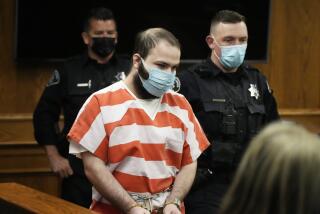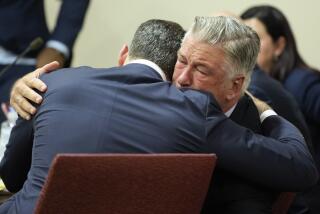Simpson Defense Rests After Elder Daughter Testifies
- Share via
O.J. Simpson’s defense rested Tuesday after four weeks of testimony aimed at discrediting the case against him as an audacious frame-up built on untrustworthy cops, unreliable witnesses and contaminated evidence.
The 39th and final witness for the defense was Simpson’s soft-voiced elder daughter, Arnelle, who neatly summed up the two primary strands of her father’s case.
First, she contradicted the testimony of three detectives about which door they used to enter Simpson’s Rockingham Avenue residence the night of the murders, pressing home the defense theme that the Los Angeles Police Department cannot be trusted. She also described her father as “very upset, sad, confused” and in shock when he learned of his ex-wife’s murder, bolstering the defense contention that Simpson acted like an innocent man, not a guilt-racked killer, throughout his ordeal.
Acquitted on criminal murder charges in 1995, Simpson is now fighting a civil lawsuit filed by the estate of Nicole Brown Simpson and by the parents of victim Ronald Lyle Goldman. The suit seeks to hold Simpson responsible for the June 12, 1994, killings and force him to pay unspecified damages to the victims’ relatives.
Jurors are expected to get the case within two weeks.
Before deliberations can begin, the plaintiffs must put on their rebuttal case. They began that job Tuesday by focusing on some hotly disputed evidence: 31 photos purporting to show Simpson wearing the same rare brand of shoes that left a trail of bloody footprints at the murder scene.
Simpson has denied ever owning or wearing the shoes in question. The photos, he has declared, are inaccurate or bogus. But the former head of the FBI’s photo analysis division, Gerald Richards, on Tuesday insisted that one of the photos is genuine; he is prepared to make similar statements about the other 30 today.
“I could find no indication whatsoever . . . of any sign of alteration to any portion of the photograph,” Richards said.
The photo Richards analyzed Tuesday was purportedly snapped by Associated Press freelancer Harry Scull at a Buffalo Bills football game on Sept. 26, 1993, about nine months before the murders. Scull said he discovered the photo in his files more than a year ago. The other 30 pictures surfaced last month. All were allegedly taken at the same football game by freelance photographer E.J. Flammer.
Flammer, 24, took the stand to authenticate his pictures Tuesday. He showed jurors the invoice he sent the Buffalo Bills for the photographs, the check stub he received from the team and the field pass he wore to gain access during the game.
But lead defense attorney Robert C. Baker ripped into him on cross-examination, noting that Flammer has copyrighted the photos and hired an agent to peddle them. His voice soaked in sarcasm, Baker asked whether it “just so happened” that Flammer “miraculously” remembered having taken incriminating photos of Simpson three years earlier--and then discovered them in his files just in time to give the plaintiffs’ case a grand finale. “Yes,” Flammer responded.
The photos were the most striking piece of new evidence to emerge in the civil case, and some legal analysts said they could prove pivotal.
By denying that he ever wore Bruno Maglis, Simpson has staked his credibility on the proposition that all 31 photos are phony.
“If the shoe photos hold up,” said Santa Monica civil attorney Brian Lysaght, “nothing else matters.”
To the defense, of course, plenty else matters.
Baker has mounted a wide-ranging case attacking the physical evidence, assailing the LAPD and asserting that Simpson has always acted like an innocent man, from the night of the murders when he signed autographs at the airport to the day he fled arrest in suicidal despair and grief.
Under oath, Simpson told jurors that he was not obsessed with Nicole, as the plaintiffs contend, and that he was distancing himself from her in the weeks before her death. Analysts credited Simpson with telling his story in a forceful and engaging manner during his two days on the stand during the defense’s case. He did not attempt to explain away any of the evidence against him. He simply told jurors he did not know how any of it got there. Then he left it up to his expert witnesses to explain why none of it could be trusted.
Only one of Simpson’s experts drew uniformly bad reviews: amateur photo analyst Robert Groden, a high school dropout who has devoted his life to researching the John F. Kennedy assassination and who has never taken classes or written articles about photo analysis.
Groden testified last month that the Scull photo--the only one he had a chance to study--was probably a forgery, based on a dozen anomalies he spotted. Yet former FBI Agent Richards, who boasts a resume of photo-related work five pages long, picked apart Groden’s points one by one in the rebuttal case.
On other topics, defense attorneys put up more evenly matched witnesses in the battle of the experts. They brought back the same team of solid forensic specialists that helped Simpson win acquittals in criminal court: pathologist Michael Baden, criminalist Henry Lee, blood-spatter analyst Herbert MacDonell, toxicologist Frederic Rieders and microbiologist John Gerdes.
The experts’ testimony laid a platform for Baker to argue that Simpson could not possibly be the murderer:
He wouldn’t have had time to commit the killings, according to Baden’s reconstruction of events. And if he did do it, he would have tracked far more blood around his home and his car than police discovered.
As for the blood that was found, defense experts declared it suspect. In Lee’s words: “Something’s wrong.”
Take, for example, the stain on Simpson’s socks that was consistent with his ex-wife’s DNA. MacDonell testified that the blood was pressed into the fabric, not splashed on during a fight. And Rieders told jurors it contained traces of the chemical EDTA, which is used to preserve blood in test tubes. Both points, Baker will argue, suggest planting.
Then there is Gerdes’ testimony that he found signs of contamination in the DNA evidence. And the photos that seem to indicate that incriminating blood turned up inside the Bronco and on a gate weeks after the murders. Baker can use it all to argue that the entire case against Simpson has been invalidated by what Loyola Law School Associate Dean Laurie Levenson called “the three Cs--contamination, corruption and conspiracy.”
To further set up his conspiracy argument, Baker peppered his case with references to former LAPD Det. Mark Fuhrman.
Now an apprentice electrician in Idaho, Fuhrman refused to answer questions at a pretrial deposition and cannot be subpoenaed to appear in person. But Baker has made sure jurors remember Fuhrman’s role in finding key evidence. He is banking on the jurors also recalling that the former detective is a convicted perjurer who was captured on tape using racial epithets and boasting of fabricating evidence.
In addition to laying out conspiracy theories, Baker has raised some provocative mysteries--which may or may not be related to the murders--for jurors to ponder:
* Why, in a crime lab photo, does a bloody glove that police said they recovered near the bodies appear to have a hole over the ring finger when the actual glove introduced into evidence has no such rip?
* Why did a television reporter call the LAPD between 10:30 and 10:45 on the night of the murders and ask if police were “sitting on” a double homicide on the Westside? The call came just about the time both sides agree the assault began; the bodies were not discovered until about midnight. There were no other double homicides on the Westside that evening.
* Who was the man with dark hair that Thomas Tallarino said he saw crouching in the grass outside Nicole Simpson’s condominium shortly before 9 p.m. on the night of the murders?
* What caused parallel lines to be imprinted in blood on an envelope, a triangular piece of paper and Goldman’s jeans? And who created the bloody footprint--another parallel line pattern--that criminalist Henry Lee observed on the walkway two weeks after the murders?
* What caused the string of seven small blood drops on the public sidewalk outside the crime scene, near a bunch of bloody paw prints? Could it have been a trail from a second assailant sneaking out the front gate while his cohort in Bruno Magli shoes walked out the back?
Baker hinted at one final mystery when he used his client’s testimony to imply that Nicole Simpson was running with a dangerous crowd in the last weeks of her life.
The judge would not allow Baker to argue that her lifestyle may have provoked her murder. But jurors will be free to reach that inference themselves, based on Simpson’s testimony about his ex-wife’s erratic behavior, her promiscuity and her friendships with drug users and prostitutes.
As the defense case came to a close, some analysts faulted Baker for throwing out so many theories without weaving them into a coherent whole.
“The plaintiffs’ case flowed out like a machine, but the defense’s case is sputtering along,” said Loyola law professor Stan Goldman, who has watched much of the trial.
“Baker’s clearly the most skilled questioner in the courtroom. He’s got a lot of acting skill, a lot of presence, and an ability to suggest volumes of innuendo with one question. But he’s being badly beaten on preparation.”
In part, analysts attributed the defense’s troubles to tactical maneuvers in the courtroom that threw Baker from his game plan.
Over the course of the trial, the plaintiffs filed dozens of motions--many of them successful--asking the judge to bar Simpson’s lawyers from probing issues they considered irrelevant, such as Fuhrman’s alleged racism.
Sometimes, they waited until the very last minute to ask the judge to intervene. As Brian “Kato” Kaelin was waiting in the hallway to take the stand, for example, the plaintiffs asked for and received a judicial order blocking the defense from asking him about Nicole Simpson’s alleged drug use. Precluded from raising the questions he had planned to ask, Baker never seemed to gain his rhythm; he sputtered his way through a few queries, then dismissed Kaelin after less than 20 minutes.
In the end, however, such bungles may not matter at all. Baker himself has told jurors that only one witness really matters--his client, the defendant.
More to Read
Sign up for Essential California
The most important California stories and recommendations in your inbox every morning.
You may occasionally receive promotional content from the Los Angeles Times.










